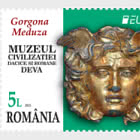The philatelic issue Romanian Pottery - Pots and Cups (III), which Romfilatelia introduces into circulation, comes to complete a previous stamp series initiated in 2007, illustrating pottery objects hand-crafted on the territory of present day Romania.
Early since the Neolithic era, pottery was the main occupational activity across the country, designed to create objects that would meet household needs. Each geographical region had its own handicraftsmen and pottery centers were widespread. On an European scale, Romania is the only country that preserved pottery techniques and art entirely.
Presently, there is still a large number of pottery centers that make use of traditional pottery techniques. The county of Arges witnesses a wide variety of pottery creation techniques and a distinctive reminder is granted by the ancient pottery center in the town of Curtea de Arges, as well as the ones in Poienita, Cosesti and Stroesti. In the county of Suceava, important pottery centers are located in Marginea, with polished black pottery, Radauti, with decorative pottery, and that named by Kuti and Paltinoasa with enamelled pots. Pottery tradition in Maramures is equally long-lasting since it has survived from Dacian times to the present day. It is interesting to observe that, in what garnishing and forms are concerned, all types of ceramics can be found. The unenamelled red ceramics using archaic decoration elements are to be found in Sacel, the enamelled horn decorative pottery is to be found in Vama, whereas the brush decorated pottery is made in Baia Sprie and Baia Mare. Besides the occupational activities of the local inhabitants, certain villagers in the county of Valcea are also specialized in pottery manufacture. During ancient times, potters were animal breeders, farmers, or fruit-growers and they would become skilled at pottery manufacture by molding various pot types during the short time they had between handling of their specific regional and occupational duties. Clay pottery manufacture in the Northern part of the county, in the depression of Horezu has brought about the set up of the Slatioara and Olari-Horezu pottery centers. Near the town of Ramnicu-Valcea, pottery centers as Buda and Vladesti are enlisted.
On the stamp with the face value of Lei 2.00 we find a handcrafted pot, made in Cosesti-Arges.
Illustrated on the stamp with the face value of Lei 2.40 is a cup made in Radauti-Suceava.
Illustrated on the stamp with the face value of Lei 6.00 is a cup made in Baia Mare-Maramures.
On the stamp with the face value of Lei 7.60 is represented a handicrafted pot, made in Vladesti-Valcea.












































